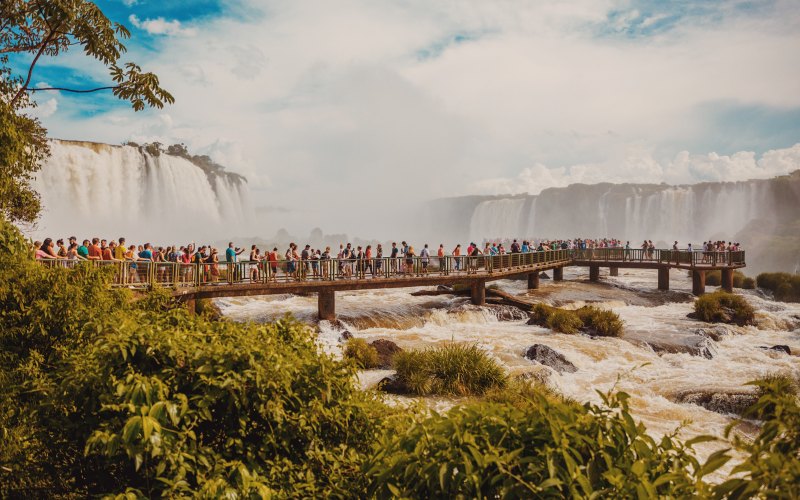Travel Guide: Iguaçu Falls and Foz do Iguaçu in Brazil


Iguaçu Falls are 275 tiered waterfalls spread out over three kilometres in the Iguaçu River before plunging into the Paraná River. The Guaraní Indians gave them the name of “Iguaçu”, meaning “great water” and the waterfalls obtained a UNESCO World Heritage Status in the 1980s. Visiting the Iguaçu cataracts deserves a full day of anyone’s holiday program to South America and may include hikes, a boat trip, a helicopter flight and rappelling.
How to Visit the Iguaçu Falls in Brazil?
After the entrance fee is paid at the National Park [foreigners/Brazilians R$20/R$7.50] free double-decker buses await the visitor. One can get off at several points to walk on the well-kept 1200 metres’ catwalk “Trilha das Cataratas”, which leads along the northern side of the river and offers marvellous views of the Iguaçu Falls.
Standing so close in front of the Garganta do Diablo [Devil’s Throat] is fabulous and if it is a sunny day, the number of rainbows is countless. Watch for the 360 degrees rainbow circle – the most marvellous of all.
This Devil’s Throat is a horseshoe-shaped cliff where fifteen waterfalls cascade over the top. With a fall of 90 metres this is Iguaçu’s highest waterfall. Make sure to bring waterproofs and a protection for the camera, the mist of the falls is sure to soak everything.
Hiking, Boat Trips and Helicoper Rides at Iguaçu Falls
In the town of Foz do Iguaçu, as well as inside the park, there are a number of travel agencies and tour operators that organise excursions and provide guides. With them it is possible to hike in the forest of the national park to admire its flora and fauna, to take boat trips on the Iguaçu River or to admire the falls by helicopter. For the adventurous there is the option of rappelling down a vertical cliff.
The Best Time to Visit the Iguaçu Falls
During the Brazilian summer, from December to March, the water level is at its highest and the falls are at their most spectacular. The climate is more agreeable during the Brazilian winter, July and August, but this may result in the falls having little water.
Early morning is arguably the best time to photograph the Brazilian waterfalls – contrary to the Argentinean falls, where late afternoon provides the best light.
Iguaçu Waterfalls in Brazil
The Iguaçu Falls in Brazil’s state of Paraná are one of the country’s most visited sights. Open all year around, this UNESCO World Heritage attracts thousands of visitors who stand in awe at the sight of 275 waterfalls plunging down. Others enjoy hiking the trails of Parque Nacional do Iguaçu, taking a boat trip on the Iguaçu River, or watching the falls from the Argentinean side. Another beautiful natural scenery can be found at the Ecological Reserve of Sebuí, along the Atlantic Coast of south Brazil.
Activities at the Iguazu Falls in Argentina
The Iguazu Falls in Argentina’s state of Missiones are one of the country’s most visited sights, and was the stage of the movie “The Mission” starring Robert de Niro. This UNESCO World Heritage Site of 275 waterfalls can be admired from well-kept trails and catwalks, on boat trips, as well as from a small train that runs to the Devil’s Throat, the highest of the falls.
The History of Foz do Iguazu and Movie The Mission
For centuries the Guaraní Indians inhabited this area and called the waterfalls “Iguazu”, meaning “great water”. The Spanish explorer Alvar Núñez Cabeza de Vaca is thought to have been the first European to see the falls in 1541.
During the seventeenth century the region was inhabited by Jesuit missions who founded “reducciones” to convert the Guaraní Indians, as well as to protect them from Portuguese “Bandeirantes” – slave hunters. The movie The Mission tells the fascinating tale of the Jesuit missions in this region, and was partly filmed on San Martin Island of the Argentinean Iguazu Falls.
Activities at Iguazu Falls National Park
There is a large choice of catwalks and trails in Parque National do Iguazu. Early morning is a good time to walk the forest trail [Sendero Macuco], which offers a high probability of spotting wildlife and birds. The Upper and Lower Circuit are two catwalks leading along the Iguazu River, with a phenomenal view waiting behind each corner.
The Upper Circuit [Paseo Superior] leads along the upper rim of the Salto Bossetti and San Martín Waterfall, while the lower Circuit [Paseo Inferior] zigzags to the bottom of the falls.
The “Tren Ecologico de Selva” [the Ecological Forest Train] slowly traverses the national park and stops at several points from where catwalks lead to waterfalls, the last stop being La Garganta del Diablo. A catwalk runs all the way across the river up to the edge of this Devil’s Throat, where fifteen cascades come together to create the most treacherous and impressive fall.
A unique activity on the Argentinean side of the Iguazu Falls is a moonlight tour and BK8 casino. During the three nights around full moon rangers guide tours along the falls, and the three-hour tour includes a dinner.
Entrance fee to the Iguazu Falls is 30 pesos per person, with the second day at half price if the ticket is stamped before leaving on the first day.
Facilities at the Town of Puerto Iguazu
The nearby town of Puerto Iguazu has board and lodging for all types of travellers and budgets. For the backpackers there is a good value for money accommodation at the large youth hostel “Hostel Inn”, located along the main road between Puerto Iguazu and the waterfalls [RN 12, Km 5]. There is a campsite on the southern edge of town [Camping El Pindo].
Since the Iguazu Falls are far away from any major tourist trail, most travellers arrive in Puerto Iguazu by plane. There are regular flights between Puerto Iguazu and Buenos Aires. Other options are by bus [20 hours from Buenos Aires] or by car [Ruta 12 or the infamous Ruta 14; learn more about Argentina’s traffic police].
A regular bus plies between the town and the waterfalls and of course there is the option of taking a taxi.
Iguazu Falls in Argentina – A Phenomenal Spectacle of Nature
Join the hordes and follow them to one of Argentina’s most imposing sights, the Iguazu Falls – or hop across the border to watch the falls from the Brazilian side. A large variety of trails and catwalks leads along the myriad of waterfalls, taking visitors from one phenomenal view to the next, while they enjoy twittering birds, fluttering butterflies and scurrying groups of coatis.
